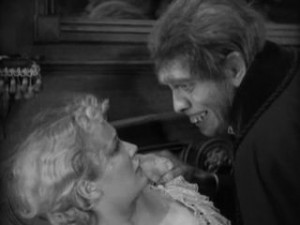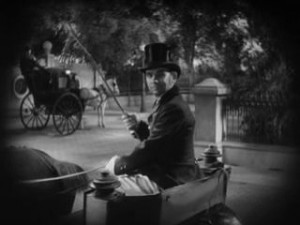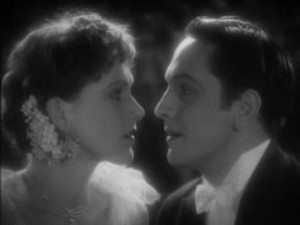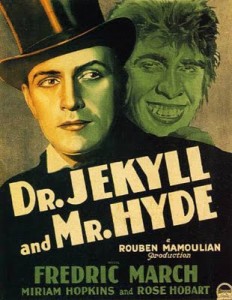Put yourself in her place! The dreaded night when her lover became a madman!
Dr Jekyll and Mr. Hyde from the great author Robert Louis Stevenson has been filmed many many times, the first time being in 1920 with John Barrymore in the title role. However, even though eclipsed in popularity by the later 1941 version with Spencer Tracy and Ingrid Bergman, the standard was set early on in 1931, with Fredric March in the dual title role, with support from Miriam Hopkins.
Written originally in 1886, Stevenson’s masterpiece deals with the beliefs of one eclectic London physician, a Dr. Jekyll, on the duality of life. Ultimately Jekyll concocts a special brew which enables him to split his good and bad personalities into separate personas and alternate between the two.
 Unfortunately over time the evil Mr. Hyde no longer requires the brew to appear and does so to Jekyll’s increasing alarm – and despair. Murders and other crimes are committed by the monster Hyde and he is ultimately killed after a chase by London’s finest. It is a story we all have know since childhood.
Unfortunately over time the evil Mr. Hyde no longer requires the brew to appear and does so to Jekyll’s increasing alarm – and despair. Murders and other crimes are committed by the monster Hyde and he is ultimately killed after a chase by London’s finest. It is a story we all have know since childhood.
So what makes such an early film such an unsurpassable classic? How long do you have – but we will keep it short. Dr. Jekyll and Mr. Hyde is so exquisitely and creatively filmed and Fredric March’s performance so powerful that it is little wonder this is the best version to date.
 Cinematically the camera angles are some of the earliest examples of some extremely creative ideas. The first few minutes are shot entirely in a somewhat telescopic first person (that of Dr. Jekyll) viewpoint, clearly setting him as the protagonist. Beyond this most shots are not straight on the actors, but rather at slightly “off” angles- and some close-ups feature simply the eyes. Karl Struss did, in fact, win an Academy Award for this effort and it is surely well deserved.
Cinematically the camera angles are some of the earliest examples of some extremely creative ideas. The first few minutes are shot entirely in a somewhat telescopic first person (that of Dr. Jekyll) viewpoint, clearly setting him as the protagonist. Beyond this most shots are not straight on the actors, but rather at slightly “off” angles- and some close-ups feature simply the eyes. Karl Struss did, in fact, win an Academy Award for this effort and it is surely well deserved.
What most often is overlooked even by those who note the great work of Karl Struss is the vertical element, most keenly when Mr. Hyde is running from the police and we get these marvelous shots of height in Dr. Jekyll’s laboratory or in the apartment where Hyde commits murder.
 The second strong point is Fredric March, who also won a well deserved Academy Award for his role. Prior to this he had almost always been cast in what one would term fluff, but here he clearly demonstrates his talents to the fullest. The shocking transformation from Jekyll (pronounced correctly here as GEE-KUL) into Hyde is not one only of makeup (which is superb) but also one of personality.
The second strong point is Fredric March, who also won a well deserved Academy Award for his role. Prior to this he had almost always been cast in what one would term fluff, but here he clearly demonstrates his talents to the fullest. The shocking transformation from Jekyll (pronounced correctly here as GEE-KUL) into Hyde is not one only of makeup (which is superb) but also one of personality.
Each time I watch I try to figure out if Fredric March is both Jekyll and Hyde, even though I know he is. The neaderthalesque makeup and complete transformation of the bubbly and socially cognizant Dr. Jekyll into the monstrous and almost physically deformed and clearly diabolically misogynistic Hyde is breathtaking.
Wonderfully this film is available readily, now complete again (MGM bought the 1931 version when the 1941 version was released and in the process 15 minutes was cut and presumed lost, including most of the racier sexual tension which is absent in the 1941 version completely). Sadly, it is usually considered a “bonus feature” to the 1941 film, when perhaps the opposite is really true.
Heartily recommended. Watch the 1931 version then compare with the latter lesser versions.

Absolutely agree with you that this is the best of all Jekyll and Hyde films. March gives a classic performance, and I quite enjoy it as an example of how Pre-Hayes Code Hollywood was better at horror.
One of the things that most impressed me about this film – and there were many – was how the transformation is shown directly as it happens, including extraordinary sound effects, ie a heartbeat played backwards). Fredric March is (literally) unrecognizable when one remembers his earlier work, good though it often was.